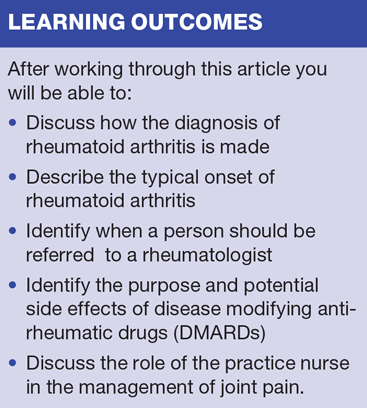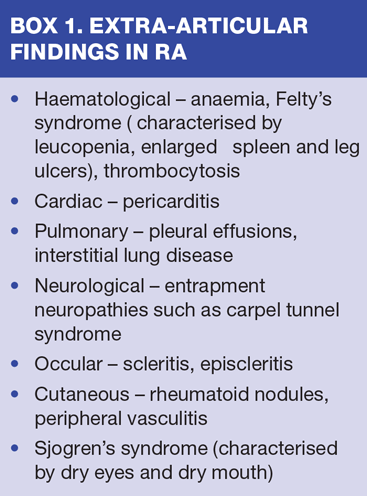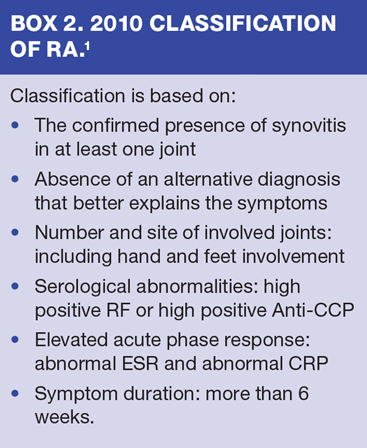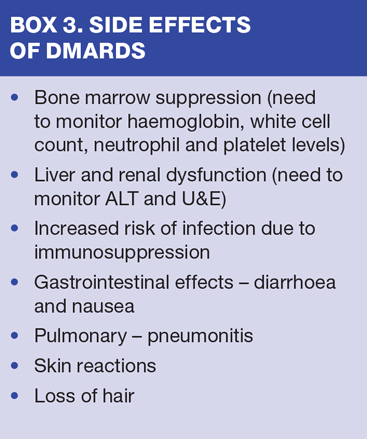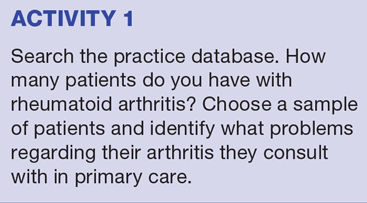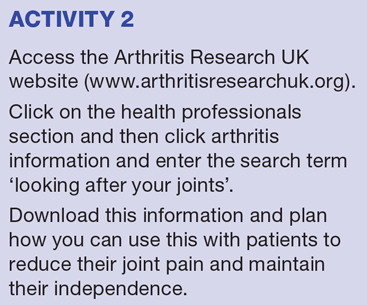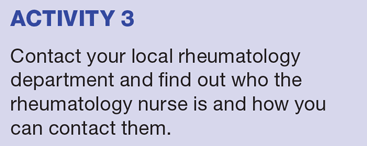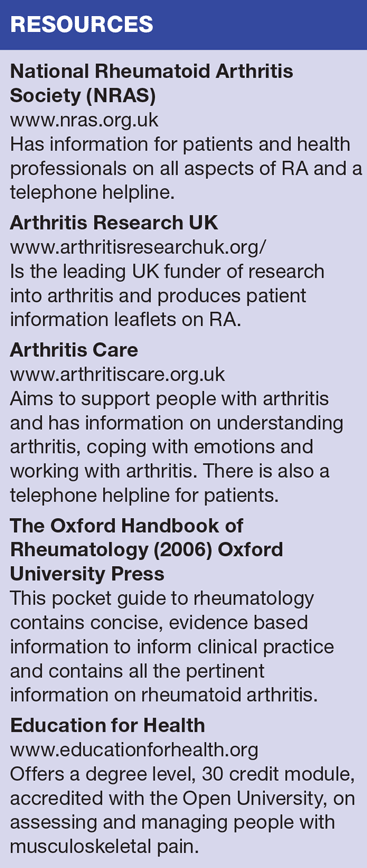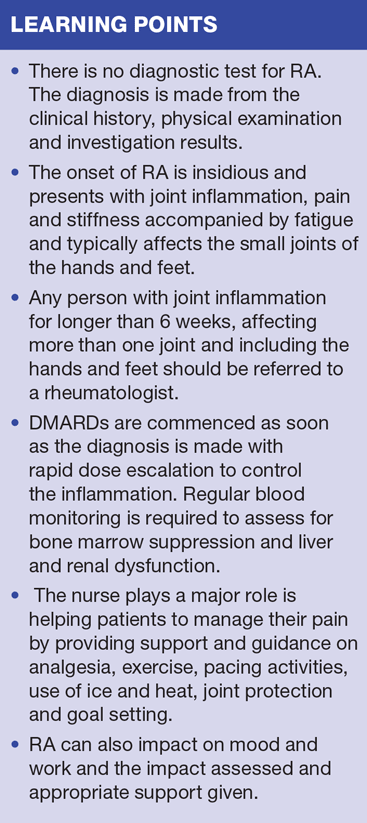Rheumatoid arthritis diagnosis and management
Sarah Ryan
Sarah Ryan
RCN, PhD, MSc, FRCN
Nurse Consultant Rheumatology Staffordshire and Stoke on Trent Partnership Trust, Honorary Senior Clinical Lecturer, School of Nursing and Midwifery,
Keele University
Advances in drug treatment have led to better outcomes in rheumatoid arthritis. Practice nurses have vital roles in the early identification of this life-changing condition and supporting patients to manage joint pain
When someone first experiences joint pain, swelling or both, they will usually go to their GP or practice nurse seeking an explanation for their symptoms. The practice nurse has a vital role to play, both in identifying people with possible rheumatoid arthritis (RA) and in supporting them once a diagnosis has been made. This article will explain what rheumatoid arthritis is, how the diagnosis is made and the pharmacological and non-pharmacological management of the condition.
IMPACT, PREVALENCE AND CAUSES
RA is a chronic inflammatory condition affecting the movable (synovial) joints of the body. It causes joint swelling, stiffness, pain, and reduced function. Inflammation in RA also has systemic effects, causing fatigue and premature mortality.1 People with RA have a similarly increased risk of cardiovascular disease as those with diabetes. Symptoms can also impact on mood, body image, work and leisure activities.
RA is estimated to affect 580,000 people in England. Approximately 26,000 cases are diagnosed each year, with a prevalence of 1:200 in women and 1:600 in men.2
The exact cause of RA remains unknown. It appears that, in a genetically predisposed individual, exposure to an as yet unidentified antigen results in the initiation of a self-perpetuating, auto-immune response which leads to joint inflammation. The synovial lining of the joint capsule becomes inflamed and congested with T lymphocytes, B cells, macrophages and plasma cells. This causes proliferation of the synovial membrane, which erodes the bone resulting in altered function, joint destruction and deformity.3
DIAGNOSIS
There is no single diagnostic test for RA. Diagnosis relies on the findings of the clinical history and examination, together with the results of a range of appropriate investigations. The RA Latex test, contrary to popular belief, is not diagnostic.
History
RA typically presents with an insidious onset of joint pain, swelling and stiffness, and an overwhelming feeling of fatigue. Joint stiffness is particularly marked on waking and can last several hours. The joint inflammation and pain will often be in the small joints of the hands and feet, and can be intra-articular (within a joint) or peri-articular (in the area around a joint). Joint symptoms will have been persistent for more than 6 weeks. A family history of RA increases the likelihood of this being the diagnosis. Data from national twin studies have shown that the heritability of RA is around 60%.
Clinical examination
On examination joint inflammation is confirmed by the presence of joint tenderness, warmth, pain and swelling. It is most commonly seen in the hands and feet and, in particular, the metacarpophalangeal joints (MCPs), the proximal interphalangeal joints (PIPs), the wrists, the metatarsophalangeal joints (MTPs) and forefoot. The 'squeeze test' is simple and one of the most reliable tests for RA. It involves squeezing a patient's hand across the knuckle joints, and the foot in a similar manner. There is a diagram demonstrating this test on the Arthritis Research UK website, included in the resource section.
All synovial joints can be affected, including the shoulders, elbows, knees and ankles. Spinal joints other than the cervical spine are very rarely involved. A presentation of more diffuse swelling is commonly seen in older people. RA can also present in a mono-articular form affecting larger joints such as the shoulders or knees. The symptoms may be confined to these areas or become more generalised affecting other joints.
The clinical examination may also identify the presence of extra-articular findings which further support the diagnosis of RA. (Box 1)
Investigations
Blood tests, ultrasonography and radiography can all be required to confirm the diagnosis of RA.
Blood tests
The erythrocyte sedimentation rate (ESR) and C-reactive protein (CRP), also known as acute phase reactants, can be used to detect inflammation. The normal range of ESR is 4-20mm/h for men and 10-25mm/h for women. The presence of infection, myeloma and age can also raise the ESR. The normal range of CRP is 0-5mg/l. A high CRP is associated with severe disease.
The rheumatoid factor (RF) is an immunoglobulin complex of immunoglobulin G (IgG) and immunoglobulin M (IGM). It is found in 1% of the normal population and the presence of RF on its own, without the symptoms of joint inflammation, is not diagnostic of the condition. A positive RF is also found in other conditions, including pulmonary fibrosis, leprosy, sarcoidosis and liver disease. RF is often absent in the first 6 months following diagnosis of RA. Joint inflammation with a positive RF is, however, suggestive of RA and patients with a positive RF are classified as having sero-positive RA.
A relatively new test called the anti-cyclic citrullinated peptide (anti-CCP) has two main functions. It can be used to diagnose RA , where it is very specific (95-98%) and sensitive (50-60%) in detecting early RA and can anticipate the clinical manifestations of RA by many years. The second function of anti-CCP is as a marker of erosive RA.
Ultrasonography and radiology
Ultrasonography is commonly used to detect early inflammation that may not be detectable on clinical examination. Conventional radiology is useful in monitoring the progression of RA. It can show soft tissue swelling, loss of joint space, loss of bone density, subluxation (partial dislocation) of the joints and articular erosions. The presence of erosions is an indicator of poor prognostic outcome.
Synovial fluid analysis
This test is rarely required to establish diagnosis in a typical presentation of RA, but if there is diagnostic doubt the aspiration and examination of synovial fluid can distinguish between RA, osteoarthritis, gout or infection.
CLASSIFICATION
There are two classification criteria for RA. The 1987 American College of Rheumatology Criteria,4 has been in widespread use to identify patients with established RA. A new set of criteria, developed in 2010,1 can identify patients with early RA. (Box 2)
REFERRAL
Referral is recommended for any person with suspected, persistent joint inflammation with a duration of over 6 weeks and affecting more than one joint, particularly if the small joints of the hands and feet are affected.5 Early identification and treatment of RA is important since this will reduce the likelihood of joint damage , joint deformity and cardiovascular disease.6
PHARMACOLOGICAL MANAGEMENT
The aim of treatment is to control inflammation, reduce pain and stiffness, prevent joint deformity, reduce systemic complications and optimise physical, psychological and social function through a combination of pharmacological and non- pharmacological interventions.
Disease modifying anti-rheumatic drugs (DMARDs), especially methotrexate and biologic agents (Table 1), have proved a major advance in the management of RA. They improve outcomes by suppressing the immune response and controlling inflammation.7-8
Following diagnosis, NICE recommends that all patients should be commenced on three DMARDs (methotrexate, sulphasalazine and hydroxychloroquine) with monthly reviews to monitor their effect. The dosage is increased over a three month period to suppress the inflammation. If a patient does not respond to DMARD therapy and the RA remains active then biologic therapy should be commenced. If the individual patient does not respond to the first biologic agent or it is not tolerated, an alternative should be offered.5
Steroids, including oral preparations (often 7.5mgs-10mgs daily) and intra-articular and intra-muscular steroid injections can be used as bridging therapy for the first three months as it takes 12 weeks for DMARDs to be effective.5 Intra-articular and intra-muscular steroids are more commonly given in the outpatient department. Simple analgesics and non-steroidal anti-inflammatory agents are used to treat symptoms of pain and stiffness.5
Like most effective drugs, DMARDs are not without side effects. (Box 3) An individual prescribed DMARDs will require regular blood tests to assess for bone marrow suppression, liver and renal dysfunction as well as the effectiveness of the treatment. This process, often referred to as blood monitoring, is usually carried out in the rheumatology department on a monthly basis for the first three months of treatment. Blood monitoring can then be taken over by the GP practice under a shared care agreement where the clinical and governance responsibilities of patient, rheumatology team and GP practice are clearly stated.
ASSESSING DISEASE ACTIVITY
A DAS28 score is used to assess whether drug treatment is working. DAS stands for 'Disease Activity Score' and 28 refers to the number of joints involved in the assessment. It is undertaken by the rheumatology nurse, who assesses the number of swollen and tender joints, obtains the CRP or ESR and asks the patient to rate their global assessment of health on a 10 point linear scale between 'very good' and 'very bad'. The results are fed into a DAS calculator (available at www.4s-dawn.com/DAS28/DAS28.html) to obtain the overall DAS score.
A DAS28 score greater than 5.1 indicates active RA, and a DAS28 less than 3.2 indicates good control of the condition. If the DAS score shows that the RA is still active then drug therapy should be stepped up.
THE NURSE'S ROLE
A diagnosis of RA can be bewildering for the patient and the symptoms can impact on all domains of function. The patient and their family will require support and information to help them to understand the condition and learn how to manage the symptoms. The first four months can be particularly challenging. It takes this amount of time for DMARDs to become effective and patients are often seen monthly by a specialist rheumatology nurse to provide education, support and escalation of drug therapy.
Pain and fatigue are the most bothersome symptoms reported by patients with RA.9 They can occur on a daily basis and are not always related to active disease. They can still be present, even when the inflammation is under control. Patients require support and guidance about how to manage these symptoms.
Coping with pain
If a particular joint, such as the wrist, is inflamed you can advise the use of ice applied to the joint (wrapped in a towel) to reduce the swelling. Heat therapies, in the form of hot packs, are well liked and commonly used for muscle pain around the joint. A wrist splint, which can be prescribed by the GP or rheumatology nurse, can also be useful to support a painful wrist joint but the patient should be advised not to use it constantly as this can cause pain by immobilising the joint for too long. If wrist pain is occurring at night then bespoke night resting splints can be ordered from the rheumatology occupational therapy or splinting department.
Advising a patient to use two hands rather than one when lifting items will help to distribute the weight so that the affected wrist is not taking all the strain. This is a concept known as joint protection; the individual should not stop using affected joints, but should learn how to use them differently.
Foot pain can be a particular problem for people with RA. The benefits of supportive footwear (wide and deep shoes) to help with shock absorbency when walking can be discussed. If the patient is finding it difficult to find a pair of supportive shoes, bespoke shoes can be made via the orthotist and a referral to the podiatrist will enable a comprehensive assessment of foot function. The referral route for this varies in different areas, but most commonly this would involve a referral back to the rheumatology team for these services.
If swelling in a particular joint doesn't settle then an intra-articular injection might be required. Most rheumatology departments have a telephone advice-line for patients and health professionals and the practice nurse could contact the rheumatology nurse to discuss this. If patients encounter a period of heightened pain and swelling it is also worth checking that they are taking their non-steroidal drugs and analgesia as prescribed.
More generalised pain and/or swelling affecting several joints may indicate a 'flare' in disease activity. The patient should be advised to contact the rheumatology nurse specialist for a reassessment of their therapy. A CRP and ESR could also be obtained to establish whether the increased symptoms are related to the RA becoming more active.
A joint that is already damaged by RA (confirmed by radiography) will not respond to escalating drug therapy. In this case referral to an orthopaedic surgeon, to assess whether surgical intervention is indicated, would be appropriate.
Coping with fatigue
Applying the concept of pacing activity can help with both pain and fatigue. This involves discussing the patient's daily routine and ensuring there are periods of both activity and rest. Planning and prioritising activities e.g. planning to spread activities over the week rather than trying to do everything within a day can help to conserve energy. Regular exercise can help with joint stiffness, joint pain, fatigue, muscle strength and maintaining joint function. Swimming, walking and cycling are all recommended forms of exercise for maintaining joint health.
Mood and social role
There is evidence that RA can have an adverse effect on mood, including anxiety and depression.10 Some patients will feel low in mood due to the frustration of not being able to do all their valued activities and some will develop clinical depression. NICE recommends that people with RA should be offered psychological interventions such as relaxation, stress management and cognitive coping skills to help them adjust to living with the condition.5 These interventions are usually provided in the community setting rather than in secondary care and can be accessed by patient self referral or GP referral.
RA also impacts on the individual's social role. It can affect work and leisure activities and patients need support and guidance as to how to address its impact. This may involve referral to a vocational rehabilitation officer who can look at the effect work is having on the RA and offer advice regarding equipment modification, altering work patterns/role and conducting a work place visit. This service should be available via referral from general practice.
CONCLUSION
RA is a chronic inflammatory condition that needs to be diagnosed early so that DMARD treatment can be commenced to control the synovitis and limit the likelihood of joint damage occurring. If DMARD treatment is not effective the dose needs to be escalated or treatment changed to biologic agents. Both the specialist and the practice nurse can have a major role in supporting patients through the diagnosis, educating them about the condition, monitoring drug therapy and working with them to develop self-management techniques to lessen the impact that RA has on their lives.
REFERENCES
1. Aletaha D, Neogi T, Silman A et al . The 2010 rheumatoid arthritis classification criteria. Arthritis and Rheumatism 2010: 62(9): 2569-2581
2. House of Commons Committee of Public Accounts. Services for people with rheumatoid arthritis. HC46 published 23 February 2010. London: The Stationery Office Limited
3. Hameed K, Akil M. Rheumatoid Arthritis: Clinical Features and Diagnosis. In Adebajo A ABC of Rheumatology 2010. Blackwell Publishing Limited
4. Arnett FC, Edworthy SM, Bloch DA et al. The ARA 1978 revised criteria for the classification of RA. Arthritis and Rheumatism 1998: 31:315-324
5. National Institute for Health and Care Excellence. Rheumatoid arthritis: the management of rheumatoid arthritis in adults. CG79 issued February 2009, modified August 2013
6. Van Dongen H, van Aken J, Lard LR et al. Efficacy of methotrexate in patients with rheumatoid arthritis: a double blind randomised placebo controlled trial. Arthritis and Rheumatism 2007: 56:1424-1432
7. Visser K, van der Heijde D. Optimal dosage and route of administration of methotrexate in rheumatoid arthritis: a systematic review of the literature. Annuals Rheumatic Disease 2009: 68:1094-1099
8. Doan T, Massarotti E. Rheumatoid arthritis: an overview of new and emerging therapies. Journal of Clinical Pharmacology 2005: 45:751-62
9. Ryan S, Lillie K, Thwaites C, Adams J. What I want clinicians to know-experiences of people with arthritis. British Journal of Nursing 2013,:22 (14):808-812
10. Treharne G, Lyons A, Booth D, Kitas G. Psychological wellbeing across 1 year with rheumatoid arthritis: coping resources as buffers of perceived stress. British Journal of Health Psychology 2007, 12:323-345
Related articles
View all Articles
